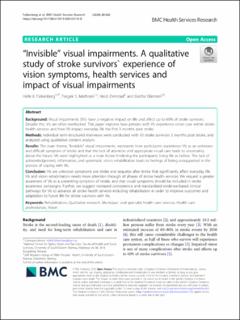| dc.contributor.author | Falkenberg, Helle Kristine | |
| dc.contributor.author | Mathisen, Torgeir Solberg | |
| dc.contributor.author | Ormstad, Heidi | |
| dc.contributor.author | Eilertsen, Grethe | |
| dc.date.accessioned | 2021-03-15T10:11:30Z | |
| dc.date.available | 2021-03-15T10:11:30Z | |
| dc.date.created | 2020-12-10T13:32:18Z | |
| dc.date.issued | 2020 | |
| dc.identifier.citation | Falkenberg, H. K., Mathisen, T. S., Ormstad, H., & Eilertsen, G. (2020). “Invisible” visual impairments. A qualitative study of stroke survivorsexperience of vision symptoms, health services and impact of visual impairments. BMC health services research, 20. | en_US |
| dc.identifier.issn | 1472-6963 | |
| dc.identifier.uri | https://hdl.handle.net/11250/2733346 | |
| dc.description.abstract | Background: Visual impairments (VIs) have a negative impact on life and affect up to 60% of stroke survivors. Despite this, VIs are often overlooked. This paper explores how persons with VIs experience vision care within stroke health services and how VIs impact everyday life the first 3 months post stroke. Methods: Individual semi-structured interviews were conducted with 10 stroke survivors 3 months post stroke, and analyzed using qualitative content analysis. Results: The main theme, “Invisible” visual impairments, represents how participants experience VIs as an unknown and difficult symptom of stroke and that the lack of attention and appropriate visual care leads to uncertainty about the future. VIs were highlighted as a main factor hindering the participants living life as before. The lack of acknowledgement, information, and systematic vision rehabilitation leads to feelings of being unsupported in the process of coping with VIs. Conclusion: VIs are unknown symptoms pre stroke and sequelas after stroke that significantly affect everyday life. VIs and vision rehabilitation needs more attention through all phases of stroke health services. We request a greater awareness of VIs as a presenting symptom of stroke, and that visual symptoms should be included in stroke awareness campaigns. Further, we suggest increased competence and standardized evidence-based clinical pathways for VIs to advance all stroke health services including rehabilitation in order to improve outcomes and adaptation to future life for stroke survivors with VIs. | en_US |
| dc.language.iso | eng | en_US |
| dc.rights | Navngivelse 4.0 Internasjonal | * |
| dc.rights.uri | http://creativecommons.org/licenses/by/4.0/deed.no | * |
| dc.title | “Invisible” visual impairments. A qualitative study of stroke survivors` experience of vision symptoms, health services and impact of visual impairments | en_US |
| dc.type | Peer reviewed | en_US |
| dc.type | Journal article | en_US |
| dc.description.version | publishedVersion | en_US |
| dc.rights.holder | © The Author(s). | en_US |
| dc.source.volume | 20 | en_US |
| dc.source.journal | BMC Health Services Research | en_US |
| dc.source.issue | 1 | en_US |
| dc.identifier.doi | https://doi.org/10.1186/s12913-020-05176-8 | |
| dc.identifier.cristin | 1858296 | |
| dc.source.articlenumber | 302 | en_US |
| cristin.ispublished | true | |
| cristin.fulltext | original | |
| cristin.qualitycode | 2 | |

